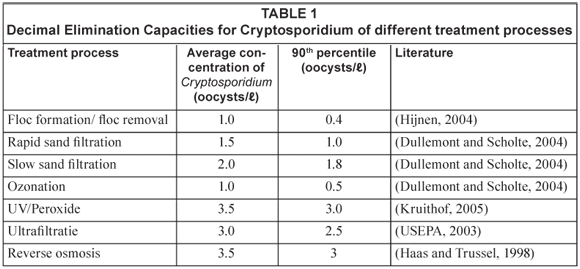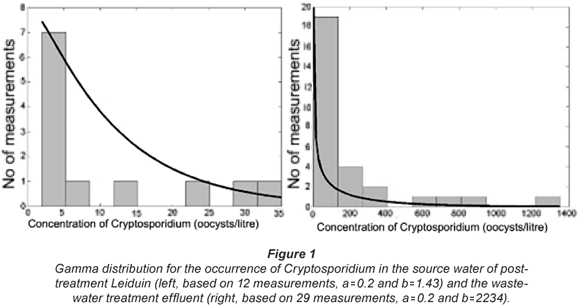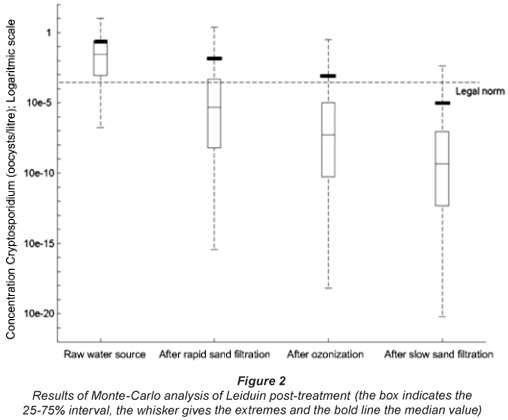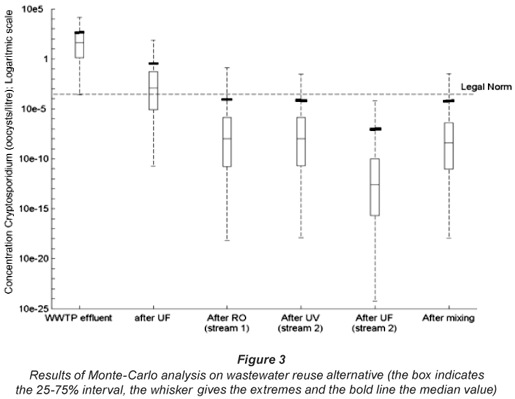Serviços Personalizados
Artigo
Indicadores
Links relacionados
-
 Citado por Google
Citado por Google -
 Similares em Google
Similares em Google
Compartilhar
Water SA
versão On-line ISSN 1816-7950
versão impressa ISSN 0378-4738
Water SA vol.35 no.2 Pretoria Jan. 2009
Assessment of Cryptosporidium in wastewater reuse for drinking water purposes: a case study for the city of Amsterdam, The Netherlands
LC RietveldI, *; L MeijerII; PWMH SmeetsIII; JP van der HoekIV
IDelft University of Technology, Department of Water Management, PO Box 5048, 2600 GA Delft, The Netherlands
IIEvides, PO Box 4472, 3006 AL Rotterdam, The Netherlands
IIIKWR, Groningenhaven 7, 3422 PE Nieuwegein, The Netherlands
IVWaternet, PO Box 94370, 1090 GJ Amsterdam, The Netherlands
ABSTRACT
Wastewater reuse is becoming increasingly important for supplementing drinking water supply needs and/or to reduce costs in many communities around the world. However, wastewater reuse can result in a potential transmission route for infectious agents. Therefore, the occurrence of Cryptosporidium was assessed in a treatment plant geared for the production of drinking water from wastewater effluent and the results were compared to those on an existing typical drinking water treatment plant operated by Waternet, the water cycle company of Amsterdam, The Netherlands, and its surrounding areas. The assessment was done using Monte-Carlo simulation and probability density functions to determine the occurrence of Cryptosporidium in raw surface water and wastewater effluent and the removal in different treatment steps. From the research conducted, it was concluded that under normal conditions, drinking water that meets Dutch drinking water quality standards could also be produced from treated wastewater effluent. However, additional redundancy should be built in to meet the standards under extreme operating conditions.
Keywords: risk assessment, wastewater reuse, drinking water treatment
Introduction
Wastewater reuse is increasingly becoming important for supplementing drinking water supply needs and/or to reduce costs in many communities around the world such as Windhoek-Namibia (Van der Merwe, 2006), Emahlaleni-South Africa (Gunther, 2006) and Wulpen-Belgium (Van Houtte and Verbauwhede, 2008). Wastewater reuse as an option becomes necessary and possible because of the increased environmental constraints, such as droughts and water scarcity, and the fact that wastewater discharge quality regulations have become stricter leading to a better water quality. Wastewater reuse practices have also become technically more feasible (Casani et al., 2005). However, wastewater reuse can result in a potential transmission route for infectious agents that are associated with human wastes and/or the presence of priority pollutants, endocrine disrupting compounds, pharmaceutically active compounds, or other unregulated trace compounds (Drewes et al., 2003). Reclamation plants must therefore be designed such that the desired effluent quality is consistently achieved. This should include built-in redundancy as a back-up when there is a problem (Cooper, 1991).
Drinking water should be free from substances with adverse health effects (e.g. organic micro-pollutants, pathogenic micro-organisms, disinfection by-products, salts, heavy metals and biofilm forming substances) and undesired substances (e.g. suspended particles). Therefore, drinking water treatment plants typically comprise several treatment steps - in a multi-barrier approach - to remove contaminants. In The Netherlands, artificial aquifer recharge is recognised as the most important barrier against pathogenic micro-organisms when producing drinking water from a surface water source. The infiltration areas for recharge are normally situated in coastal dune areas, which are relatively long transport distances away from the raw water source and the city, being a costly practice. Wastewater treatment plants are normally situated close to the city and could therefore provide an alternative raw water source for drinking water, thus avoiding the long transport distances between the dunes, raw water and the city. Treatment of wastewater in The Netherlands is continually improving, resulting in better treated effluent water quality similar to that of raw surface water. Therefore, combining wastewater and drinking water treatments could provide synergistic advantages. The question, however, is whether this alternative for drinking water production is a sustainable solution.
From recent studies it was concluded that current drinking water treatment practices in The Netherlands have a low environmental impact (Barrios et al., 2008; Tapia et al., 2008). Also, the costs of tap water are acceptable for the consumers. The most significant challenge for water utilities is to prevent consumers switching to bottled water. Bottled water is about 150 times more expensive than tap water and 30 times less environmentally friendly. In addition, wide variations in taste between tap water and bottled water are not detected by Dutch consumers (Consumentenbond, 2005), which means that the safety of drinking water consumption would prevail over cost reduction and environmental protection. It is therefore important to assess the health risk of different alternatives before deciding whether to switch to treated wastewater effluent as a source for drinking water production.
One of the emerging contaminants is Cryptosporidium. Cryptosporidium is a protozoan parasite that has been responsible for a number of negative public health outbreaks of diarrhoea in humans that have occurred through public water supply systems (Craun et al., 1998; Hrudey and Hrudey, 2004). This was due in part to the high infectivity of Cryptosporidium as well as to the resistance of the protozoan parasite to chemical disinfection. Subsequent to these outbreaks many drinking water companies have begun to measure the concentration of Cryptosporidium in their sources. The Dutch drinking water legislation (Dutch Government, 2001) requires compliance with a health target of 1 infection per 10 000 persons per year. The average direct consumption of unheated drinking water in The Netherlands has been recorded to be 0.22 ℓ/person·d (Roda Husman and Medema, 2004). Hence, only one infectious pathogen, i.e. Cryptosporidium, is allowed in the distribution of 812 m3 of drinking water. Teunis et al. (1996) determined the relationship between the consumed dose of Cryptosporidium and the number of infections to be 0.004. To comply with the Dutch legislation, the yearly average Cryptosporidium concentration needs to be less than 3.08 x 10-4 oocysts/ℓ.
This research project assessed the removal of Cryptosporidium when producing potable water from wastewater effluent in a treatment plant. The results were compared to the performance of a typical drinking water treatment plant, i.e Leiduin of Waternet, the water cycle company responsible for potable water provision to Amsterdam and its surrounding areas. The assessment was done using the Monte-Carlo simulation technique and probability density functions (PDF) to determine the occurrence of Cryptosporidium in raw water and the removal efficiencies of different treatment steps.
Methodology
Monte-Carlo simulation and probability density functions
The Monte Carlo method is just one of many methods for analyzing uncertainty propagation, where the goal is to determine how random variation affects the reliability of the system that is being modelled. Monte Carlo simulation is categorised as a sampling method because the inputs are randomly generated from probability distributions to simulate the process of sampling from an actual population.
The variation in the product water quality, i.e. concentration of Cryptosporidium, can be estimated when the stochastic distributions of the occurrence in the source and of the removal efficiency in treatment steps are known. The occurrence of the compounds in the product water was estimated stochastically using Monte-Carlo simulation. The Monte-Carlo simulation was programmed within the Statistics toolbox of MatlabTM. Randomly, a large number of independent samples from the different stochastic distributions were taken and a PDF of the product water was composed.
The source water quality was well monitored and hence, available as datasets. These datasets were directly translated into a PDF. The gamma distribution was chosen in this study since it had been applied earlier by Haas et al. (1999). One of the characteristics of a gamma distribution is that it is not necessarily symmetric like a normal distribution. This characteristic enables a more accurate description of extremes in a dataset. The gamma distribution is represented by the formula:

with the gamma function:

where:
a and b are calibration parameters.
the mean of the gamma distribution is a*b and the variance is a*b2
The parameters a and b were calculated with the function 'gamfit' of MatlabTM.
The PDFs of the removal efficiency of the different treatment steps were constructed with limited data. This was due to limited availability of data and the difficulty of detecting low concentrations of Cryptosporidium. For each individual treatment step the removal of Cryptosporidium was determined. The average and 'worst case' removal were estimated from literature and expert judgement. These data were then used to fit a beta distribution (Teunis et al., 1999). It was assumed that the 'worst case' removal had a likelihood of occurrence of 90%. The beta distribution needed the parameters a and b to describe the process. The beta distribution is represented by the formula:

where:
I(0,1)(x) is the indicator function to keep the distribution within the interval of zero to one.
The mean of the beta distribution is a/(a+b) and the variance is:

The Leiduin surface water treatment plant, Waternet
Waternet draws two thirds of its raw water from the Lekkanaal, a canal connected to the river Rhine, near Nieuwegein in the central region of The Netherlands. The raw water is pre-treated by means of coagulation, sedimentation and rapid sand filtration and pumped to the dune area. The dunes are then artificially recharged and the water is extracted about 3 months later from an open reservoir called 'Oranjekom' for post-treatment at Leiduin. This comprises aeration, rapid sand filtration, ozonation, softening, granular activated carbon filtration and slow sand filtration. The product water is distributed in the city of Amsterdam without the addition of chlorine for disinfection.
Scheme of possible water treatment plant for producing drinking water from treated wastewater effluent at Amsterdam-West
In this study it was proposed to use treated effluent from the Amsterdam-West wastewater treatment plant for drinking water production. The proposed treatment scheme comprised pre-treatment by coagulation and flotation, followed by ultrafiltration, nitrification/denitrification in sand filters, ultraviolet/hydrogen peroxide oxidation and disinfection, biological activated carbon filtration and ultrafiltration. A quarter of the flow was to be treated by reverse osmosis (RO) to reduce salt concentrations, typically found in treated wastewater effluent, and this step was placed after the first ultrafiltration step. The partial flows were thereafter to be mixed into the clear water tanks.
Decimal elimination capacities for the removal of Cryptosporidium by different treatment steps
Decimal elimination capacities (DEC) for the removal of Cryptosporidium by different treatment steps are given in Table 1.

Scenarios for the comparison of the 2 alternative raw water sources
In addition to the analysis for normal operating conditions, 2 sets of scenarios were modelled in order to assess the robustness of the drinking water treatment processes to extreme conditions. These were:
-
Scenario 1a: An increase in Cryptosporidium in the raw surface water of 'Oranjekom' to 11 oocysts/ℓ
-
Scenario 1b: An increase in Cryptosporidium in the raw wastewater effluent to 100.000 oocysts/ℓ
-
Scenario 2a: Failure of the most effective treatment step in the drinking water plant produced from surface water, i.e. the slow sand filtration step
-
Scenario 2b: Failure of the most effective treatment step in the drinking water plant produced from treated wastewater effluent, i.e. the reverse osmosis step.
Results and discussion
Probability density functions for raw water sources
In the Lekkanaal the concentration of Cryptosporidium varied between 2 and 35 oocysts/ℓ. The dataset for Cryptosporidium in the source water of the post-treatment Leiduin consisted of 12 data points collected over 12 months. In 2 samples no Cryptosporidium was detected and these samples were given a value equal to the minimum detection limit of 2 oocysts/ℓ. The concentration of Cryptosporidium in the source water of the post-treatment was on average 0.3 oocysts/ℓ and the highest measured value of 1 oocyst/ℓ was set as the 90th percentile (Dullemont and Scholte, 2004). The dataset of the wastewater treatment plant effluent consisted of 29 data points and the concentration of Cryptosporidium varied between 2 and 1 350 oocysts/ℓ (Medema, 2001). Normally not all Cryptosporidium oocysts can be detected. Therefore a recovery percentage had to be adopted and the measured concentrations had to be compensated for the limitations of the detection method. Medema (2001) determined a recovery percentage of 27%. This percentage was also used in this study. Figure 1 displays the distribution of the collected data and the calibrated gamma distribution.

Treatment plants functioning under normal conditions
Figure 2 shows the results of the Monte-Carlo analysis for the Cryptosporidium concentrations at the post-treatment Leiduin. After treatment, the median concentration was 9.5 x 10-6 oocysts/ℓ. In 1% of the total number of random, independent samples from the dataset the concentration of Cryptosporidium after treatment exceeded the legal guideline of 3.08 x 10-4 oocysts/ℓ.

When treated wastewater effluent was used as the raw water source for drinking water production, the median concentration of Cryptosporidium in drinking water was 3.3 x 10-5 oocysts/ℓ (Fig. 3). In this alternative, no additional removal credits were given to the nitrification/denitrification step and in 1.7% of the total number of random, independent samples from the dataset the concentration of Cryptosporidium after treatment exceeded the legal guideline limit of 3.08 x 10-4 oocysts/ℓ. This could be explained by the variation of the influent concentration.

Both alternatives therefore gave an acceptable drinking water quality without excessive risks.
Treatment plants functioning under extreme operating conditions
In Fig. 4 the effects of the extreme operating conditions are represented.

In extreme circumstances both the typical potable water treatment situation and the wastewater effluent reuse alternative were shown to be vulnerable. When the artificial aquifer recharge was by-passed or the concentration in 'Oranjekom' was comparable to the concentration in the Lekkanaal, on average, the legal maximum concentration was not reached. It became worse when the slow-sand filtration was not performing well under existing conditions. However, because of its robustness and years of operation, this is not likely to occur. For the wastewater reuse alternative for drinking water production the situation was also calculated to be unsatisfactory. On the one hand, extreme events in wastewater reuse were more pronounced when, e.g., an outbreak of Cryptosporidiosis would occur in the city under consideration and wastewater treatment would be hampered. On the other hand, the probability of failure of membrane filtration is relatively high. In order to avoid risks it was therefore found to be necessary to include extra redundancy in the system. This could be reached by avoiding open abstraction in the dune area for the existing situation and by including extra treatment steps in the scheme for the wastewater effluent reuse alternative, i.e. extra disinfection, membrane filtration or artificial aquifer recharge.
Conclusions
In this research Monte Carlo analysis was done for the assessment of Cryptosporidium occurrence and removal in the existing drinking water treatment plant of Leiduin and in a proposed scheme for the reuse of wastewater effluent for drinking water purposes. It was concluded that in the normal situation both alternatives complied with Dutch water quality legislation. However, under extreme circumstances, i.e. increased Cryptosporidium concentrations and failure of treatment steps, the schemes did not comply. The situation was determined to be more critical in the case of wastewater reuse than for the existing scheme for drinking water production. It is proposed that treatment plants be equipped with additional redundancy to avoid health risks in extreme situations.
References
BARRIOS R, SIEBEL M, VAN DER HELM A, BOSKLOPPER K and GIJZEN H (2008) Environmental and financial life cycle impact assessment of drinking water production at Waternet. J. Clean. Prod. 16 (4) 471-476. [ Links ]
CASANI S, ROUHANy M and KNOCHEL S (2005) A discussion paper on challenges and limitations to water reuse and hygiene in the food industry. Water Res. 39 (6) 1134-1146. [ Links ]
CONSUMENTENBOND (2005) Test tap water and bottled water. Consumentengids 6 (in Dutch). [ Links ]
COOPER RC (1991) The hygienic aspects of wastewater reuse. Waste Manage. Res. 9 (1) 373-377. [ Links ]
CRAUN GF HUBBS SA FROST F CALDERON RL and VIA SH (1998) Waterborne outbreaks of Cryptosporidiosis. J. Am. Water Works Assoc. 90 81-91. [ Links ]
DREWES JE, REINHARD M and FOX P(2003) Comparing microfiltration-reverse osmosis and soil-aquifer treatment for indirect potable reuse of water. Water Res. 37 (15) 3612-3621. [ Links ]
DULLEMONT YJ and SCHOLTE PW (2004) Preliminary Risk Assessment of Cryptosporidium and Giardia in the Pre-Treatment at Nieuwegein and the Treatment Process at Leiduin, Trend Analysis over the years 1997 until 2002. Waternet (in Dutch). [ Links ]
DUTCH GOVERNMENT (2001) Besluit van 9 januari 2001 tot wijziging van het waterleidingbesluit in verband met de richtlijn betreffende de kwaliteit van voor menselijke consumptie bestemd water. Staatsblad van het Koninkrijk der Nederlanden 31 53 pp. [ Links ]
GUNTHER P (2006) Regional Mine Water Treatment Opportunities. Lectures presented at the Water Supply Short Course. 26 july 2006, University of the Witwatersrand, johannesburg, South Africa. [ Links ]
HAAS CN, ROSE JB and GERBA CP (1999) Quantitative Microbial Risk Assessment. john Wiley & Sons, New york, USA. [ Links ]
HAAS CN and TRUSSELL RR (1998) Frameworks for assessing reliability of multiple, independent barriers in potable water reuse. Water Sci. Technol. 38 (6) 1-8. [ Links ]
HRUDEY SE and HRUDEY EJ (2004) Safe Drinking Water – Lessons Learned from Recent Outbreaks in Affluent Nations. IWA Publishing, London. [ Links ]
HIJNEN WAM (2004) Elimination of Micro-Organisms by Drinking Water Treatment Process. Kiwa Nieuwegein, The Netherlands. [ Links ]
KRUITHOF JC (2005) UV/H2O2 retrofit of PWN's treatment plant Andijk for primary disinfection and organic contaminant control In: Door Water Verbonden, 57e Vakantiecursus in Drinkwatervoorziening en 24e Vakantiecursus in Riolering & Afvalwaterbehanderling. TU Delft, The Netherlands. [ Links ]
MEDEMA GJ (2001) Cryptosporidium and Giardia: Occurrence in Sewage Water, Manure and Surface Water with Swimming and Drinking Water Function (in Dutch). RIWA/RIVM/RIZA/KIWA, The Netherlands. [ Links ]
RODA HUSMAN AM and Medema Gj (2004) Inspection Guidelines Analysis Microbiological Safety Drinking Water (in Dutch). Kiwa Nieuwegein, The Netherlands. [ Links ]
TAPIA M, SIEBEL MA, VAN DER HELM AWC, BAARS ET and GIJZEN HJ (2008) Environmental, financial and quality assessment of drinking water processes at Waternet. J. Clean. Prod. 16 (4) 401-409. [ Links ]
TEUNIS PFM (1996) The Dose-Response Relation in Human Volunteers for Gastro-Intestinal Pathogens. RIVM, The Netherlands. [ Links ]
TEUNIS PFM, EVERS EG and SLOB W (1999) Analysis of variable fractions resulting from microbial counts. Quant. Microbiol. 1 (1) 63-88. [ Links ]
US EPA (2003) Long Term 2 Enhanced Surface Water Treatment Rule, Toolbox Guidance Manual. United States Environmental Protection Agency, Washington, USA. [ Links ]
VAN DER MERWE B (2006) Water reuse in Windhoek through a dual pipe system and artificial recharge of the aquifer. Proc. Int. Water Reuse Workshop organized by the Water and Wastewater Agency. 17-19 May, Tijuana Baja, Mexico. [ Links ]
VAN HOUTTE E and VERBAUWHEDE J (2008) Operational experience with indirect potable reuse at the Flemish coast. Desalination 218 (1-3) 198-207. [ Links ]
This paper was originally presented at the 2008 Water Institute of Southern Africa (WISA) Biennial Conference, Sun City, South Africa, 18-22 May 2008.
* To whom all correspondence should be addressed.
+31 152783347; fax: +31 152794918;
e-mail: L.C.Rietveld@tudelft.nl














